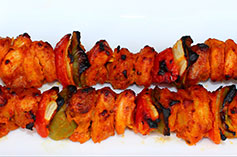
Chicken Thigh Boneless
Chicken thigh is upper part of the leg, and is used to cook variety of dishes all over the world. Since it is dark colored meat, it has more flavor, and it remains juicy and tender when cooked on high heat or slow cooked. Chicken thigh can be used in many ways to prepare dishes. These can be roasted, grilled, sauteed, pan-fried, baked or curried.
Chicken thigh has more muscle and fat - 4 ounces of boneless and skinless chicken thigh has 69% protein, 31% fat, and 0% carbohydrates. Both dark and white chicken meat is a good source of proteins, vitamins A, K, B6, B12, folate, niacin, and minerals such as iron, selenium, phosphorus, and zinc.
Buy chicken with USDA organic seal to make sure that the chicken is raised on food that does not contain animal by-products and is not raised with antibiotics
Chicken thigh has more muscle and fat - 4 ounces of boneless and skinless chicken thigh has 69% protein, 31% fat, and 0% carbohydrates. Both dark and white chicken meat is a good source of proteins, vitamins A, K, B6, B12, folate, niacin, and minerals such as iron, selenium, phosphorus, and zinc.
Buy chicken with USDA organic seal to make sure that the chicken is raised on food that does not contain animal by-products and is not raised with antibiotics
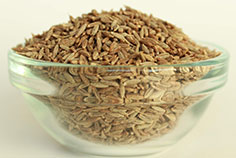
Cumin Seeds
Native to the Mediterranean regions and northern Africa, cumin has been cultivated for thousands of years in the Middle East, India, China and the Mediterranean. Cumin is one of the most consumed spices in the world.
Cumin is a drought tolerant and grows best in warm, dry climates. Ideal temperatures for growing cumin is between 77°F to 86°F. Depending on the location, cumin has a growing season of 3 to 4 months. The plant produces small white or pink flowers and dark green seed pods. The seeds are harvested when the plant starts to wilt and the seed pods changes from dark green to brownish yellow.
India has been the largest producer of cumin with around 75% of the total crop produced, followed by Syria, Turkey, Iran, and China.
Cumin is used to in various curry powders and spice blends to flavor dishes in India, Middle East, Mexico, Portugal, and Spain. Cumin adds nutty and spicy taste to the grilled meat, soups and stews, sausages, pickles, and rice and bean dishes. It is also used to make liqueur - an alcoholic drink consumed after meal. Oil of cumin is used in fragrances.
Cumin can be used as whole seed or in powdered form that are easily available in grocery stores or can be made at home by grinding the cumin seeds. Many people prefer to buy cumin seeds over powder because seeds last longer at room temperature and it’s very easy to ground cumin seeds into powder.
Cumin seeds last for about an year whereas cumin powder lasts for about six months at room temperature. Store the cumin seeds or powder in a tight lid jar in a cool, dark, and dry place. If you do not use it often in your cooking then keep the seeds or powder in the freezer to last up to 2 years.
In addition to adding flavor to the dishes, cumin helps in digestion and digestive problems. The essential oil in cumin activates the salivary glands in mouth that helps in primary digestion of food. The presence of essential oil, sodium, and magnesium in cumin provides relief from stomach aches. The essential oil in cumin also relieves stress and anxiety and helps inducing sleep. Presence of caffeine in combination with essential oil loosen up and eliminate mucus and phlegm in respiratory tract, which help to heal the initial condition leading to respiratory disorders such as asthma.
Packaged cumin seeds are available in Indian and South Asian grocery stores. Some of the popular brands of cumin seeds are SWAD, Frontier, Deep, and Nirav. You may also find it in supermarkets or gourmet markets. It is available at online grocery stores such as amazon.com, where you will be able to choose from several brands.
Cumin is a drought tolerant and grows best in warm, dry climates. Ideal temperatures for growing cumin is between 77°F to 86°F. Depending on the location, cumin has a growing season of 3 to 4 months. The plant produces small white or pink flowers and dark green seed pods. The seeds are harvested when the plant starts to wilt and the seed pods changes from dark green to brownish yellow.
India has been the largest producer of cumin with around 75% of the total crop produced, followed by Syria, Turkey, Iran, and China.
Cumin is used to in various curry powders and spice blends to flavor dishes in India, Middle East, Mexico, Portugal, and Spain. Cumin adds nutty and spicy taste to the grilled meat, soups and stews, sausages, pickles, and rice and bean dishes. It is also used to make liqueur - an alcoholic drink consumed after meal. Oil of cumin is used in fragrances.
Cumin can be used as whole seed or in powdered form that are easily available in grocery stores or can be made at home by grinding the cumin seeds. Many people prefer to buy cumin seeds over powder because seeds last longer at room temperature and it’s very easy to ground cumin seeds into powder.
Cumin seeds last for about an year whereas cumin powder lasts for about six months at room temperature. Store the cumin seeds or powder in a tight lid jar in a cool, dark, and dry place. If you do not use it often in your cooking then keep the seeds or powder in the freezer to last up to 2 years.
In addition to adding flavor to the dishes, cumin helps in digestion and digestive problems. The essential oil in cumin activates the salivary glands in mouth that helps in primary digestion of food. The presence of essential oil, sodium, and magnesium in cumin provides relief from stomach aches. The essential oil in cumin also relieves stress and anxiety and helps inducing sleep. Presence of caffeine in combination with essential oil loosen up and eliminate mucus and phlegm in respiratory tract, which help to heal the initial condition leading to respiratory disorders such as asthma.
Packaged cumin seeds are available in Indian and South Asian grocery stores. Some of the popular brands of cumin seeds are SWAD, Frontier, Deep, and Nirav. You may also find it in supermarkets or gourmet markets. It is available at online grocery stores such as amazon.com, where you will be able to choose from several brands.

Onion
Most researchers agree that onion has been cultivated for 5000 years or more, and they were first grown in central Asia. Others suggest that onions were first grown in Iran and western Pakistan. Onions can be grown in a variety of soils and climates and are less perishable; therefore, it is believed that they were domesticated simultaneously all over the world. It is interesting to know that Egyptians worshiped onions and believed that concentric rings of onions symbolize eternal life.
Due to pungent taste and smell, humans started onions to protect their plants from animals and insects. The strong flavor of onions comes from sulphur compounds, which onion plants absorb from soil when growing. When an onion is cut, certain enzyme breaks out producing strong sulphurous smell.
Cooking alters the strong and pungent taste of onions into meaty taste that adds flavor to various dishes in many cultures. Onions are also eaten in raw form to garnish many dishes. Cut onions can be rinsed properly to remove sulphur, when eaten raw. You can also put the onions in the freezer for 20-30 minutes to minimize the release of sulphurous smell and taste.
The sulphur compounds, flavonoids (antioxidants), and fructans (small carbohydrate molecules) help prevent cancer, stomach ulcer, and reduce symptoms of diabetes mellitus.
Whole dry onions should be stored at room temperature at dry place with proper ventilation. Do not store onions in closed plastic bags. Netted or punched bags are best to store whole onions for better ventilation, and last upto 4 weeks. Cut onions needs to be refrigerated. Cut onions stored in a sealed container can last up to a week.
Due to pungent taste and smell, humans started onions to protect their plants from animals and insects. The strong flavor of onions comes from sulphur compounds, which onion plants absorb from soil when growing. When an onion is cut, certain enzyme breaks out producing strong sulphurous smell.
Cooking alters the strong and pungent taste of onions into meaty taste that adds flavor to various dishes in many cultures. Onions are also eaten in raw form to garnish many dishes. Cut onions can be rinsed properly to remove sulphur, when eaten raw. You can also put the onions in the freezer for 20-30 minutes to minimize the release of sulphurous smell and taste.
The sulphur compounds, flavonoids (antioxidants), and fructans (small carbohydrate molecules) help prevent cancer, stomach ulcer, and reduce symptoms of diabetes mellitus.
Whole dry onions should be stored at room temperature at dry place with proper ventilation. Do not store onions in closed plastic bags. Netted or punched bags are best to store whole onions for better ventilation, and last upto 4 weeks. Cut onions needs to be refrigerated. Cut onions stored in a sealed container can last up to a week.

Garlic Cloves
Native to central Asia, Garlic is one of the earliest plants that human used for flavoring food dishes as well as maintaining a good health. Garlic became an important ingredient in cooking many dishes in various parts of the world, such as, Asian countries including Middle East, northern Africa, southern Europe, and parts of South and Central America. However, Garlic was not popular in the USA until the beginning of twentieth century. By the year 1940, Americans recognized the importance of Garlic and started using it to season various recipes.
A Garlic bulb is a bunch of individual segments called cloves (like an orange segment). Each Garlic clove can be separated off the bunch and peeled before use to flavor any recipe. A Garlic clove can be used as a whole, sliced, crushed, or in the form of paste. Each way of using Garlic provides a different flavor to the recipes. For example, whole and sliced garlic provides mild taste than crushed and paste form.
Due to higher concentration of fructose and significantly less water content, Garlic is browned quickly when frying or roasting. Therefore, Garlic needs to be cooked carefully. If you are cooking food in a pan or a wok, one way is to add Garlic toward the end of cooking, in the last few minutes. However, Garlic added at the end of the cooking will provide a stronger taste. Some people like it, some don’t. Cooking Garlic at the beginning will mellow down the strong taste. To add garlic at the beginning of cooking and yet prevent from burning, cook the Garlic at a low heat and preferably in a smaller pan or wok. You can change the heat from low to medium after adding other ingredients with garlic. Garlic cooked this way will provide mild taste to the food. Garlic is best roasted in an oven by wrapping the cloves or whole bulb in an aluminum foil at 400 degrees Fahrenheit for about 40 minutes.
Though garlic is best known for flavoring food, it has also been used to maintain good health and for increasing strength. Usage of garlic in food may also help prevent many heart and blood system related conditions, such as, high blood pressure, high cholesterol, and coronary heart disease. It’s also believed that consumption of garlic on a regular basis reduces the risk of getting certain cancer, such stomach cancer, colon cancer, and lung cancer. For maximum health benefits, slice, crush, or make garlic paste 10 minutes before cooking. When a garlic clove is broken down, the ruptured cell releases the sulphur-based compound, alliin and an enzyme called alliinase. They come in contact with each other to form a new compound called alliicin, which is responsible for medicinal properties of Garlic. Allowing the cut Garlic to sit for about 10 minutes before cooking provides maximum health benefits due to optimal synthesis of alliicin.
Whole fresh garlic should be stored at room temperature at dry and dark place with proper ventilation. Do not store garlic in closed plastic bags. It’s best to store garlic in netted or punched bags for better air circulation. Refrigeration or freezing changes the texture and flavor of garlic. However, cut or peeled garlic needs to sealed in a container or air tight bag and refrigerated for later use.
A Garlic bulb is a bunch of individual segments called cloves (like an orange segment). Each Garlic clove can be separated off the bunch and peeled before use to flavor any recipe. A Garlic clove can be used as a whole, sliced, crushed, or in the form of paste. Each way of using Garlic provides a different flavor to the recipes. For example, whole and sliced garlic provides mild taste than crushed and paste form.
Due to higher concentration of fructose and significantly less water content, Garlic is browned quickly when frying or roasting. Therefore, Garlic needs to be cooked carefully. If you are cooking food in a pan or a wok, one way is to add Garlic toward the end of cooking, in the last few minutes. However, Garlic added at the end of the cooking will provide a stronger taste. Some people like it, some don’t. Cooking Garlic at the beginning will mellow down the strong taste. To add garlic at the beginning of cooking and yet prevent from burning, cook the Garlic at a low heat and preferably in a smaller pan or wok. You can change the heat from low to medium after adding other ingredients with garlic. Garlic cooked this way will provide mild taste to the food. Garlic is best roasted in an oven by wrapping the cloves or whole bulb in an aluminum foil at 400 degrees Fahrenheit for about 40 minutes.
Though garlic is best known for flavoring food, it has also been used to maintain good health and for increasing strength. Usage of garlic in food may also help prevent many heart and blood system related conditions, such as, high blood pressure, high cholesterol, and coronary heart disease. It’s also believed that consumption of garlic on a regular basis reduces the risk of getting certain cancer, such stomach cancer, colon cancer, and lung cancer. For maximum health benefits, slice, crush, or make garlic paste 10 minutes before cooking. When a garlic clove is broken down, the ruptured cell releases the sulphur-based compound, alliin and an enzyme called alliinase. They come in contact with each other to form a new compound called alliicin, which is responsible for medicinal properties of Garlic. Allowing the cut Garlic to sit for about 10 minutes before cooking provides maximum health benefits due to optimal synthesis of alliicin.
Whole fresh garlic should be stored at room temperature at dry and dark place with proper ventilation. Do not store garlic in closed plastic bags. It’s best to store garlic in netted or punched bags for better air circulation. Refrigeration or freezing changes the texture and flavor of garlic. However, cut or peeled garlic needs to sealed in a container or air tight bag and refrigerated for later use.
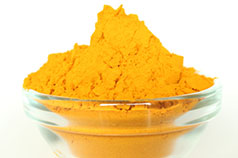
Turmeric Powder
Turmeric powder is a bright and deep yellow colored powder made by grinding dried underground stems of turmeric, which is starchy in nature. In India and some of its neighboring countries, turmeric in stem or powdered form has been used to color skin and clothing and to add color and aroma to food. It is also used as a pious powder during festivals and marriage ceremonies. In other parts of the world, turmeric is mainly used to add color and aroma to food. Turmeric has pungent and bitter taste but musky and mild fragrance.
Turmeric powder is made by steaming or boiling the underground stems in slightly alkaline water (measures above 7.0 on the pH scale) to precook the starch in turmeric. The alkaline water also improves the color of turmeric. Boiled turmeric stems are sun-dried and ground to make powder.
Turmeric powder is mainly used in curries, stir fried dishes, and dry rubs. It is also used in some spicy salad dressing and smoothies and drinks.
The compound called curcuminoids in turmeric is responsible for its yellow color and has antioxidant and preservative properties. Due to its antioxidant properties, use of turmeric in food helps prevent certain type of cancer, lowers cholesterol, lowers the risk of cardiovascular diseases, and protects from Alzheimer’s disease. Due to its preservative property, use of turmeric in food helps in extending the shelf-life of food.
Turmeric has also been used in Indian and Chinese system of medicine as an anti-inflammatory agent to treat various conditions such as toothache, bruises, chest pain, and digestion problems. In addition, turmeric contains very good amounts of minerals like iron, calcium, potassium, manganese, zinc, copper, and magnesium.
Store turmeric powder in a tightly sealed container in a cool, dark, and dry place. At room temperature, turmeric powder will taste fresh for 4 to 6 months. Refrigerate it for a longer shelf-life of up to 2 years.
Turmeric powder is available in Indian and South Asian grocery stores. Some of the popular brands of turmeric powder are Nirav, Deep, SWAD, Spicy World, and Jiva. You may also find it in supermarkets or gourmet markets. It is available at online grocery stores such as amazon.com, where you will be able to choose from several brands.
Turmeric powder is made by steaming or boiling the underground stems in slightly alkaline water (measures above 7.0 on the pH scale) to precook the starch in turmeric. The alkaline water also improves the color of turmeric. Boiled turmeric stems are sun-dried and ground to make powder.
Turmeric powder is mainly used in curries, stir fried dishes, and dry rubs. It is also used in some spicy salad dressing and smoothies and drinks.
The compound called curcuminoids in turmeric is responsible for its yellow color and has antioxidant and preservative properties. Due to its antioxidant properties, use of turmeric in food helps prevent certain type of cancer, lowers cholesterol, lowers the risk of cardiovascular diseases, and protects from Alzheimer’s disease. Due to its preservative property, use of turmeric in food helps in extending the shelf-life of food.
Turmeric has also been used in Indian and Chinese system of medicine as an anti-inflammatory agent to treat various conditions such as toothache, bruises, chest pain, and digestion problems. In addition, turmeric contains very good amounts of minerals like iron, calcium, potassium, manganese, zinc, copper, and magnesium.
Store turmeric powder in a tightly sealed container in a cool, dark, and dry place. At room temperature, turmeric powder will taste fresh for 4 to 6 months. Refrigerate it for a longer shelf-life of up to 2 years.
Turmeric powder is available in Indian and South Asian grocery stores. Some of the popular brands of turmeric powder are Nirav, Deep, SWAD, Spicy World, and Jiva. You may also find it in supermarkets or gourmet markets. It is available at online grocery stores such as amazon.com, where you will be able to choose from several brands.
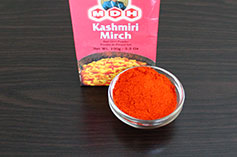
Kashmiri Red Chili Powder
Coming Soon...

Salt
Salt is a mineral composed of a chemical compound called sodium chloride. It is essential for human body to regulate fluid balance and to control function of nerves and muscles. Human body cannot produce its own salt and depends on various sources of salt in food for necessary daily intake.
In addition to being just a diet supplement, salt helps in extracting the real flavors of savory as well as sweet dishes. No other seasoning has been found so fulfilling to replace salt. However, the overuse of salt results into a lot of health problems, such as hypertension, heart disease, and strokes. Use salt mildly in your food to you can enjoy its goodness.
In addition to being just a diet supplement, salt helps in extracting the real flavors of savory as well as sweet dishes. No other seasoning has been found so fulfilling to replace salt. However, the overuse of salt results into a lot of health problems, such as hypertension, heart disease, and strokes. Use salt mildly in your food to you can enjoy its goodness.

Lime Juice
Lime juice or juice extracted from lime is a great source of vitamin C and used to add tartness and freshness to food and beverages. It also a natural preservative and slows down the spoilage of food. The juice is squeezed from fresh cut lime or bought readymade at grocery stores or supermarkets.
Best quality lime is bright deep green in color and is firm and heavy for its size. More ripen lime turn yellow in color; however it is best when green. Lime produces more juice when warmer. Therefore, to get the most juice out of lime, bring it to room temperature (if refrigerated) and roll it under your palm against a hard surface to warm it more, before squeezing. Another quick method is to microwave it for 15-30 seconds, let it sit for a few minutes before cutting and squeezing.
In addition to its use in food and drinks, lime juice also provides health benefits that include weight loss, skin care, and improved digestion. Due to the presence of significant amount of vitamin C, it helps in curing scurvy, which is caused due to vitamin C deficiency. Vitamin C in lime juice also acts as an antioxidant and helps in strengthening the immune system.
Lime or packaged lime juice is available in grocery stores throughout the year. Lime will stay fresh for a week at room temperature when kept away from sunlight. You can also store it in your refrigerator’s crisper tray for about a month, if bought fresh.
Best quality lime is bright deep green in color and is firm and heavy for its size. More ripen lime turn yellow in color; however it is best when green. Lime produces more juice when warmer. Therefore, to get the most juice out of lime, bring it to room temperature (if refrigerated) and roll it under your palm against a hard surface to warm it more, before squeezing. Another quick method is to microwave it for 15-30 seconds, let it sit for a few minutes before cutting and squeezing.
In addition to its use in food and drinks, lime juice also provides health benefits that include weight loss, skin care, and improved digestion. Due to the presence of significant amount of vitamin C, it helps in curing scurvy, which is caused due to vitamin C deficiency. Vitamin C in lime juice also acts as an antioxidant and helps in strengthening the immune system.
Lime or packaged lime juice is available in grocery stores throughout the year. Lime will stay fresh for a week at room temperature when kept away from sunlight. You can also store it in your refrigerator’s crisper tray for about a month, if bought fresh.
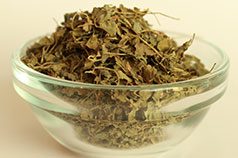
Dried Fenugreek leaves
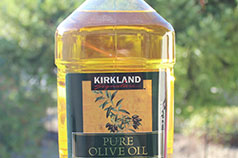
Olive Oil
Olive is one of the oldest known cultivated trees in the world. It is said that Olive trees are being cultivated before the invention of written language. Olive trees are draught tolerant and are native to eastern Mediterranean region. The trees can survive and bear fruits for a thousand year. Olives are small fruits of the Olive tree. During prehistoric time, people use to grind and drain the pulp of olives to get oil for cooking and lighting lamps. Oil extracted from olives was also used for cosmetic purposes.
Today, olive oil is popular than any other oil for culinary use and health benefits. About 90% of the olive fruit produce goes toward the production of olive oil. The oil is produced by pressing the whole olives and is used for cooking, cosmetics, pharmaceutical uses, and as fuel for certain lamps.
Olive oil used for cooking and eating is broadly classified as extra virgin, virgin, pure, and light. The difference is mainly in the process of production of different verities, due to which they contain different levels of antioxidant and have different smoking point.
Extra virgin olive oil is the best quality and is extracted using mechanical process such as cold pressing and centrifugation. The olives are pressed at normal temperature without the use of heating and chemicals. This method of extraction helps preserve most of the antioxidants and hence, makes the oil of high quality. The extra virgin olive oil smokes at a very low temperatures ranging from 200 to 372 degree Fahrenheit depending upon the quality (the better the quality have higher smoking point). Therefore, extra virgin olive oil is considered cold dishes like salad dressing and dips as well as cooking at a medium heat. You can use the good quality extra virgin oil to sauté vegetables, shallow frying eggs, and meats. It’s not recommended to use extra virgin olive oil for deep frying at higher temperatures.
Virgin olive oil is extracted using the same process as extra virgin. It has same levels of monounsaturated fats, antioxidant, and has the similar smoking point. It’s different from extra virgin because it’s made using relatively ripe olives, which gives it light flavor. The usage of virgin oil for cooking is same as extra virgin oil.
Pure olive oil has the same monounsaturated fat content, but has less antioxidant. Pure olive oil, also called olive oil, is a blend of virgin oil and refined pomace oil (also called refined olive oil). Pomace oil, a leftover during the extraction of extra virgin and virgin oils, is refined before mixing it to the virgin oil. The blend contains only about 5 to 10% of virgin oil. It’s lighter in taste, and has higher smoking point that makes it fit for sautéing and frying.
Light olive oil has the same percentage of monounsaturated fat, but lowest level of antioxidants. It’s basically refined olive oil, manufactured by the using some chemical and heat to get rid of impurities. It’s smoking point is highest and is ideal for high temperature cooking, such as deep frying and baking.
At higher temperatures, required for deep frying, extra virgin and virgin oil lose their antioxidant properties and flavor. Therefore, many cooks use pure or light olive oil for frying. Some views suggest that cooking with extra virgin and virgin olive oil at high temperatures is harmful for health; however, there is no substantial evidence to support such views. This might be a myth or a truth. Therefore, to be on the safe side, it’s advisable to use pure and light olive oil for higher temperature cooking such as deep frying, and use good quality extra virgin and virgin olive oil for cold dishes and cooking at medium temperature such as sautéing.
Because of the higher monounsaturated fat content, all kinds of olive oil lasts longer than other oils. After opening, close the cap or lid completely and store in a cool, dark, and dry place, and use it within 3 – 4 months from opening. Due to the presence of antioxidant substances, extra virgin and virgin oils are more resistant to damage by oxygen in air. However, the chlorophyll in the oil makes them vulnerable to damage by light. Therefore, always store the extra virgin and virgin oil in a dark place away from light. Refrigeration slightly solidifies the oil, which comes back to its liquid state when kept at room temperature, but will lose its flavor.
Olive oil has high content of antioxidants called polyphenols, carotenoids, and tocopherols. It’s high in monounsaturated fat and has low saturated and polyunsaturated fat. This composition makes it healthy for heart and for prevention of many medical conditions like, cancer, high blood pressure, and diabetes. According to some recent research, consumption of olive oil improves calcium absorption; hence, prevents the onset osteoporosis.
You can buy olive oil at any grocery store. It is available at online grocery stores such as www.amazon.com. Type the kind of olive oil you want to buy on search bar, you will be able to choose from several options.
Today, olive oil is popular than any other oil for culinary use and health benefits. About 90% of the olive fruit produce goes toward the production of olive oil. The oil is produced by pressing the whole olives and is used for cooking, cosmetics, pharmaceutical uses, and as fuel for certain lamps.
Olive oil used for cooking and eating is broadly classified as extra virgin, virgin, pure, and light. The difference is mainly in the process of production of different verities, due to which they contain different levels of antioxidant and have different smoking point.
Extra virgin olive oil is the best quality and is extracted using mechanical process such as cold pressing and centrifugation. The olives are pressed at normal temperature without the use of heating and chemicals. This method of extraction helps preserve most of the antioxidants and hence, makes the oil of high quality. The extra virgin olive oil smokes at a very low temperatures ranging from 200 to 372 degree Fahrenheit depending upon the quality (the better the quality have higher smoking point). Therefore, extra virgin olive oil is considered cold dishes like salad dressing and dips as well as cooking at a medium heat. You can use the good quality extra virgin oil to sauté vegetables, shallow frying eggs, and meats. It’s not recommended to use extra virgin olive oil for deep frying at higher temperatures.
Virgin olive oil is extracted using the same process as extra virgin. It has same levels of monounsaturated fats, antioxidant, and has the similar smoking point. It’s different from extra virgin because it’s made using relatively ripe olives, which gives it light flavor. The usage of virgin oil for cooking is same as extra virgin oil.
Pure olive oil has the same monounsaturated fat content, but has less antioxidant. Pure olive oil, also called olive oil, is a blend of virgin oil and refined pomace oil (also called refined olive oil). Pomace oil, a leftover during the extraction of extra virgin and virgin oils, is refined before mixing it to the virgin oil. The blend contains only about 5 to 10% of virgin oil. It’s lighter in taste, and has higher smoking point that makes it fit for sautéing and frying.
Light olive oil has the same percentage of monounsaturated fat, but lowest level of antioxidants. It’s basically refined olive oil, manufactured by the using some chemical and heat to get rid of impurities. It’s smoking point is highest and is ideal for high temperature cooking, such as deep frying and baking.
At higher temperatures, required for deep frying, extra virgin and virgin oil lose their antioxidant properties and flavor. Therefore, many cooks use pure or light olive oil for frying. Some views suggest that cooking with extra virgin and virgin olive oil at high temperatures is harmful for health; however, there is no substantial evidence to support such views. This might be a myth or a truth. Therefore, to be on the safe side, it’s advisable to use pure and light olive oil for higher temperature cooking such as deep frying, and use good quality extra virgin and virgin olive oil for cold dishes and cooking at medium temperature such as sautéing.
Because of the higher monounsaturated fat content, all kinds of olive oil lasts longer than other oils. After opening, close the cap or lid completely and store in a cool, dark, and dry place, and use it within 3 – 4 months from opening. Due to the presence of antioxidant substances, extra virgin and virgin oils are more resistant to damage by oxygen in air. However, the chlorophyll in the oil makes them vulnerable to damage by light. Therefore, always store the extra virgin and virgin oil in a dark place away from light. Refrigeration slightly solidifies the oil, which comes back to its liquid state when kept at room temperature, but will lose its flavor.
Olive oil has high content of antioxidants called polyphenols, carotenoids, and tocopherols. It’s high in monounsaturated fat and has low saturated and polyunsaturated fat. This composition makes it healthy for heart and for prevention of many medical conditions like, cancer, high blood pressure, and diabetes. According to some recent research, consumption of olive oil improves calcium absorption; hence, prevents the onset osteoporosis.
You can buy olive oil at any grocery store. It is available at online grocery stores such as www.amazon.com. Type the kind of olive oil you want to buy on search bar, you will be able to choose from several options.
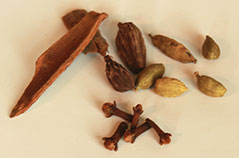
Whole Garam Masala
An authentic garam masala is a collection of four spices either in whole or powdered form. The four spices, green cardamom, black cardamom, clove, and cinnamon stick added in the right proportion enhances the flavor and aroma of the dishes. The word ‘garam’ means warm or hot and ‘masala’ means spice; however, garam masala does not mean that the spices are hot. It means that the spices raise your body temperature by increasing the metabolism. The taste of garam masala in food is intense (not hot) yet pleasant.
Either in whole or powdered form, it is an essential ingredient in many Indian and South Asian cuisine. The whole garam masala is usually added to the hot oil before other ingredients to release its flavor to the oil. On the other hand, the garam masala powder is added to the dishes with other powdered spices while cooking or just for seasoning the dishes toward the end of the cooking. Garam masala is used to flavor a variety of curries, stews, and soups and marinades and rubs for barbecue. Green cardamom, cinnamon, and clove are used to flavor a wide range of desserts.
Store the whole or powdered garam masala in a tight lid jar in a cool, dark, and dry place. It will last for about six months at room temperature. If you do not use it often in your cooking then keep it in the freezer to last up to 2 years.
In addition to the adding wonderful flavor and aroma to the food, garam masala helps in boosting metabolism and promoting weight loss. It helps in absorbing nutrients and lowering blood sugar. It also helps in detoxification.
You can buy whole or powdered garam masala at any Indian or South Asian grocery store or gourmet markets.
Either in whole or powdered form, it is an essential ingredient in many Indian and South Asian cuisine. The whole garam masala is usually added to the hot oil before other ingredients to release its flavor to the oil. On the other hand, the garam masala powder is added to the dishes with other powdered spices while cooking or just for seasoning the dishes toward the end of the cooking. Garam masala is used to flavor a variety of curries, stews, and soups and marinades and rubs for barbecue. Green cardamom, cinnamon, and clove are used to flavor a wide range of desserts.
Store the whole or powdered garam masala in a tight lid jar in a cool, dark, and dry place. It will last for about six months at room temperature. If you do not use it often in your cooking then keep it in the freezer to last up to 2 years.
In addition to the adding wonderful flavor and aroma to the food, garam masala helps in boosting metabolism and promoting weight loss. It helps in absorbing nutrients and lowering blood sugar. It also helps in detoxification.
You can buy whole or powdered garam masala at any Indian or South Asian grocery store or gourmet markets.

Red Tomato
Tomatoes started to grow as small berries on bushes in western South America, but were not eaten. Mexicans were the first to use tomatoes in cooking, and gradually tomatoes were used as food throughout the world. However, tomatoes were considered unfit for eating in European countries until early 19th century, due to resemblance with deadly nightshade, a poisonous plant. Around the year 1820, tomatoes started to be seen in European vegetable markets, mainly due to immigration and blending of culture. Italian-Americans ate tomatoes and brought them to Italy. Therefore, Italy was the first European country to cultivate tomatoes for consuming as food.
Today, thousands of varieties of tomatoes are eaten all over the world. You can use any type of red colored tomato for Indian curry recipes. However, for making tomato soup, Roma tomatoes are best as they are relatively dry and have few seeds.
Buy tomatoes that are heavy for its size, firm, and deeply colored. For the best taste, tomatoes should be cooked with skin, outer fleshy wall beneath the skin, and jelly and juice surrounding the seeds, and then strained for fineness. This process helps restore acidity and aroma of the tomatoes. Also, tomato skin contains maximum lycopene, so cooking tomatoes with skin helps in getting more antioxidant in food.
Tomatoes are rich in vitamin A and C, and the red varieties are excellent source of antioxidant carotenoid lycopene (which makes them red). Lycopene in tomatoes may help in reducing the formation of free radicals known to cause cancer. New research has shown that antioxidant power of tomatoes increases when the tomatoes are cooked.
Tomatoes taste best when stored at room temperature. The fresh flavor and aroma of tomatoes is compromised when refrigerated. For best taste and texture, refrigerated tomatoes should be allowed to come back to room temperature before eating.
Today, thousands of varieties of tomatoes are eaten all over the world. You can use any type of red colored tomato for Indian curry recipes. However, for making tomato soup, Roma tomatoes are best as they are relatively dry and have few seeds.
Buy tomatoes that are heavy for its size, firm, and deeply colored. For the best taste, tomatoes should be cooked with skin, outer fleshy wall beneath the skin, and jelly and juice surrounding the seeds, and then strained for fineness. This process helps restore acidity and aroma of the tomatoes. Also, tomato skin contains maximum lycopene, so cooking tomatoes with skin helps in getting more antioxidant in food.
Tomatoes are rich in vitamin A and C, and the red varieties are excellent source of antioxidant carotenoid lycopene (which makes them red). Lycopene in tomatoes may help in reducing the formation of free radicals known to cause cancer. New research has shown that antioxidant power of tomatoes increases when the tomatoes are cooked.
Tomatoes taste best when stored at room temperature. The fresh flavor and aroma of tomatoes is compromised when refrigerated. For best taste and texture, refrigerated tomatoes should be allowed to come back to room temperature before eating.

Ginger
Native to Southeastern Asia, Ginger is popularly used as a spice and medicine in both eastern and western cultures. Ginger was used by ancient Romans and later, after the fall of Roman Empire, was traded in Europe by Arabs who took over the spice trade. Ginger became very expensive like other spices, and in medieval times, was traded in preserved form to make sweet treats.
For many years, ginger has been used to flavor a wide variety of food, from meats and sausages to fish and vegetables, and various curries as well as drinks and desserts. Fresh ginger can be used as sliced, crushed, or as paste.
Ginger has antioxidant and anti-inflammatory properties; therefore, it’s used in traditional medicine to cure a variety of ailments, such as, gastrointestinal distress, motion sickness, arthritis, and cold and flu. Cooking food with small quantity of ginger on a regular basis also adds to health benefits.
The distinct flavor and medicinal property of ginger comes from gingerols, shogaols, and zingerone. Fresh ginger contains gingerol an anti-inflammatory compound that is believed to help in reducing osteoarthritis or rheumatoid arthritis pain, if consumed on a regular basis. It may also prevent growth of certain cancer. Gingerol is transformed into shogaols when dried and cooked. Also, when ginger is cooked gingerol and shogaols is transformed into zingerone. Due to the presence of zingerone, food cooked with ginger has a sweet and spicy flavor. The anti-inflammatory and antioxidant properties of zingerone help in prevention and cure of many medical problems. Dry ginger alone has strong flavor due to shogaols used in many medicines as well as compliments cookies, cakes, and candies recipes, and tea and drinks.
In addition to the use for culinary and medicinal purposes, ginger is also used to fragrance many soaps and cosmetics.
Ginger is sold in many forms in supermarkets, such as fresh, dried, powdered, preserved, crystallized, and as oil. You will find ginger paste, a popular way of using ginger to make curries in Asian countries, in Asian and South Asian grocery stores. Be sure to use ginger in the recipe in the form it’s advised. For example, if a recipe calls for fresh ginger, it cannot be replaced with dry or powdered or other types. Each form of ginger has a distinct taste and different purpose.
Ginger is best stored as whole and unpeeled in a sealed plastic bag in refrigerator. If part of the ginger has been cut or peeled, be sure to dry it before storing. Other forms of ginger are mainly packaged and need to be stored as per instructions by the seller.
For many years, ginger has been used to flavor a wide variety of food, from meats and sausages to fish and vegetables, and various curries as well as drinks and desserts. Fresh ginger can be used as sliced, crushed, or as paste.
Ginger has antioxidant and anti-inflammatory properties; therefore, it’s used in traditional medicine to cure a variety of ailments, such as, gastrointestinal distress, motion sickness, arthritis, and cold and flu. Cooking food with small quantity of ginger on a regular basis also adds to health benefits.
The distinct flavor and medicinal property of ginger comes from gingerols, shogaols, and zingerone. Fresh ginger contains gingerol an anti-inflammatory compound that is believed to help in reducing osteoarthritis or rheumatoid arthritis pain, if consumed on a regular basis. It may also prevent growth of certain cancer. Gingerol is transformed into shogaols when dried and cooked. Also, when ginger is cooked gingerol and shogaols is transformed into zingerone. Due to the presence of zingerone, food cooked with ginger has a sweet and spicy flavor. The anti-inflammatory and antioxidant properties of zingerone help in prevention and cure of many medical problems. Dry ginger alone has strong flavor due to shogaols used in many medicines as well as compliments cookies, cakes, and candies recipes, and tea and drinks.
In addition to the use for culinary and medicinal purposes, ginger is also used to fragrance many soaps and cosmetics.
Ginger is sold in many forms in supermarkets, such as fresh, dried, powdered, preserved, crystallized, and as oil. You will find ginger paste, a popular way of using ginger to make curries in Asian countries, in Asian and South Asian grocery stores. Be sure to use ginger in the recipe in the form it’s advised. For example, if a recipe calls for fresh ginger, it cannot be replaced with dry or powdered or other types. Each form of ginger has a distinct taste and different purpose.
Ginger is best stored as whole and unpeeled in a sealed plastic bag in refrigerator. If part of the ginger has been cut or peeled, be sure to dry it before storing. Other forms of ginger are mainly packaged and need to be stored as per instructions by the seller.
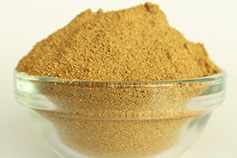
Coriander Powder
Coriander, also known as cilantro and Chinese parsley, is an herb native to Southeastern Europe and is cultivated in Egypt, Middle East, China, India, and Turkey. Coriander powder is made by grinding the dried or roasted seeds of coriander plant. The seeds are small (2-3 mm long), oval in shape, and light brown in color. Coriander powder provides mild-nutty flavor and aroma to many savory and sweet dishes.
Due to its mild-nutty taste and aroma, coriander powder is an essential ingredient in many vegetable and meat curry preparations and barbecue rubs and sauces. It is also added to waffle and pancake mixes and dessert sauces for an enhanced taste.
The presence of coriander powder in food stimulates the taste buds and helps digestion. Including coriander in your diet has many health benefits. It is a great source of potassium, iron, vitamin A, K and C, folic acid, magnesium, and calcium. It is a good source of antioxidants and helps detoxify the body.
Coriander powder is easily available in grocery stores or can be made at home by grinding the coriander seeds. To make coriander powder at home:
Due to its mild-nutty taste and aroma, coriander powder is an essential ingredient in many vegetable and meat curry preparations and barbecue rubs and sauces. It is also added to waffle and pancake mixes and dessert sauces for an enhanced taste.
The presence of coriander powder in food stimulates the taste buds and helps digestion. Including coriander in your diet has many health benefits. It is a great source of potassium, iron, vitamin A, K and C, folic acid, magnesium, and calcium. It is a good source of antioxidants and helps detoxify the body.
Coriander powder is easily available in grocery stores or can be made at home by grinding the coriander seeds. To make coriander powder at home:
- Either dry the coriander seeds in sun for a couple of days or slightly roast the seeds without oil in a pan. Roasting the seeds before grinding enhances the taste and aroma of the coriander powder. Also, drying in sun or roasting removes moisture from the seeds and adds crispness, which helps in powdering the seeds.
- Let the seeds cool and then grind them in a spice grinder. You can also use a coffee grinder for grinding spices; however it’s not recommended to use the same grinder for grinding spices and coffee.
- Store coriander powder in a tightly sealed container in a cool, dark, and dry place. If you are making coriander powder at home, cool it down before storing. It usually last for 4-6 months at room temperature. Refrigerate it for a longer shelf life of 18-24 months.
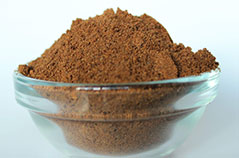
Garam Masala Powder
An authentic garam masala is a collection of four spices either in whole or powdered form. The four spices, green cardamom, black cardamom, clove, and cinnamon stick added in the right proportion enhances the flavor and aroma of the dishes. The word ‘garam’ means warm or hot and ‘masala’ means spice; however, garam masala does not mean that the spices are hot. It means that the spices raise your body temperature by increasing the metabolism. The taste of garam masala in food is intense (not hot) yet pleasant.
Either in whole or powdered form, it is an essential ingredient in many Indian and South Asian cuisine. The whole garam masala is usually added to the hot oil before other ingredients to release its flavor to the oil. On the other hand, the garam masala powder is added to the dishes with other powdered spices while cooking or just for seasoning the dishes toward the end of the cooking. Garam masala is used to flavor a variety of curries, stews, and soups and marinades and rubs for barbecue. Green cardamom, cinnamon, and clove are used to flavor a wide range of desserts.
Readymade garam masala powder is available in Indian or South Asian grocery stores or gourmet markets. However, the readymade masala contains several ingredients in addition to the four basic spices, which makes it not taste exactly like the authentic garam masala. I have tried it once and decided to make my own at home. It tastes good, but does not taste like real garam masala. However, you can go ahead and try to see if you like it.
There are two methods to make garam masala powder at home:
Method 1:
Most grocery stores that sell Indian or South Asian spices, also sell powdered green cardamom, cinnamon, and clove individually in small packets. Go ahead and buy the spices powder and mix them at home in the proportion listed below:
Black Cardamom Powder - 2 tablespoon
Cinnamon Powder – 1 tablespoon
Green Cardamom Powder – 1/2 tablespoon
Clove Powder – 1/2 tablespoon
The above ingredients mixed together will make ½ cup (4 ounces) garam masala powder.
Method 2:
This is the tradition method of making garam masala at home by roasting and grinding the whole garam masala as follows:
Whole black cardamom pods – 6 (Use whole, not shelled)
Whole cinnamon sticks – 5 (3 inches long)
Whole green cardamom pods – 10 (Use whole, not shelled)
Whole cloves - 12
Since we are using whole cardamom pods with shell, the above ingredients together after grinding will make a little more than ½ cup garam masala powder.
Slightly roast or warm the above listed whole spices for about 2-3 minutes and let it cool. Then grind them together in a spice grinder or a coffee grinder designated for grinding spices only. Roasting or warming the spices adds crispness and intensifies the flavor and aroma of the spices. Cool the powdered garam masala before storing.
Store the masala powder in a tight lid jar in a cool, dark, and dry place. It will last for about six months at room temperature. If you do not use it often in your cooking then keep it in the freezer to last up to 2 years.
In addition to the adding wonderful flavor and aroma to the food, garam masala helps in boosting metabolism and promoting weight loss. It helps in absorbing nutrients and lowering blood sugar. It also helps in detoxification.
You can buy whole or powdered garam masala at any Indian or South Asian grocery store or gourmet markets. It is available at online grocery stores such as amazon.com. Type the name of garam masala spice you want to buy on search bar, you will be able to choose from several brands.
Either in whole or powdered form, it is an essential ingredient in many Indian and South Asian cuisine. The whole garam masala is usually added to the hot oil before other ingredients to release its flavor to the oil. On the other hand, the garam masala powder is added to the dishes with other powdered spices while cooking or just for seasoning the dishes toward the end of the cooking. Garam masala is used to flavor a variety of curries, stews, and soups and marinades and rubs for barbecue. Green cardamom, cinnamon, and clove are used to flavor a wide range of desserts.
Readymade garam masala powder is available in Indian or South Asian grocery stores or gourmet markets. However, the readymade masala contains several ingredients in addition to the four basic spices, which makes it not taste exactly like the authentic garam masala. I have tried it once and decided to make my own at home. It tastes good, but does not taste like real garam masala. However, you can go ahead and try to see if you like it.
There are two methods to make garam masala powder at home:
Method 1:
Most grocery stores that sell Indian or South Asian spices, also sell powdered green cardamom, cinnamon, and clove individually in small packets. Go ahead and buy the spices powder and mix them at home in the proportion listed below:
Black Cardamom Powder - 2 tablespoon
Cinnamon Powder – 1 tablespoon
Green Cardamom Powder – 1/2 tablespoon
Clove Powder – 1/2 tablespoon
The above ingredients mixed together will make ½ cup (4 ounces) garam masala powder.
Method 2:
This is the tradition method of making garam masala at home by roasting and grinding the whole garam masala as follows:
Whole black cardamom pods – 6 (Use whole, not shelled)
Whole cinnamon sticks – 5 (3 inches long)
Whole green cardamom pods – 10 (Use whole, not shelled)
Whole cloves - 12
Since we are using whole cardamom pods with shell, the above ingredients together after grinding will make a little more than ½ cup garam masala powder.
Slightly roast or warm the above listed whole spices for about 2-3 minutes and let it cool. Then grind them together in a spice grinder or a coffee grinder designated for grinding spices only. Roasting or warming the spices adds crispness and intensifies the flavor and aroma of the spices. Cool the powdered garam masala before storing.
Store the masala powder in a tight lid jar in a cool, dark, and dry place. It will last for about six months at room temperature. If you do not use it often in your cooking then keep it in the freezer to last up to 2 years.
In addition to the adding wonderful flavor and aroma to the food, garam masala helps in boosting metabolism and promoting weight loss. It helps in absorbing nutrients and lowering blood sugar. It also helps in detoxification.
You can buy whole or powdered garam masala at any Indian or South Asian grocery store or gourmet markets. It is available at online grocery stores such as amazon.com. Type the name of garam masala spice you want to buy on search bar, you will be able to choose from several brands.
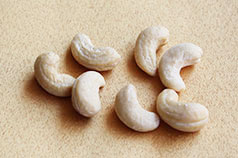
Cashew Nut
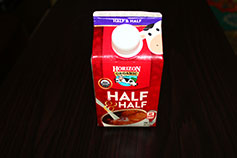
Half & Half

Water
Coming Soon...
Share your thoughts and questions!


